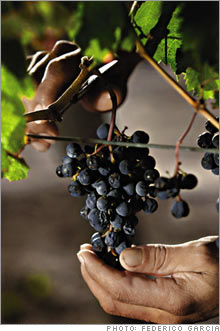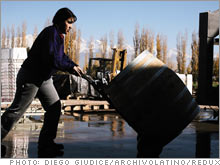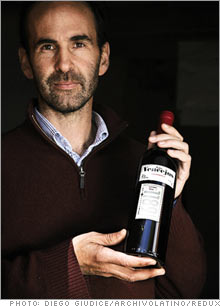U.S. wine-makers flock to ArgentinaThe South American country's currency crisis opened the door for overseas entrepreneurs to buy its vineyards at low prices.(FSB Magazine) Mendoza, Argentina -- Viña Cobos co-owner Andrea Marchiori tightens her smile ever so slightly as she eyes my pant leg and shoe, now spattered with the oxygenated blood purple of malbec wine. "We'll get you a rag for that," she says.
One of the first skills wine connoisseurs develop is the bull's-eye spittoon shot. Besides staving off the liver damage that looms as an occupational hazard, it lets you taste dozens of wines without getting hopelessly plastered - very important when you're driving 30 miles between tasting rooms. But this morning, after a seven-hour flight delay pushed my arrival in Mendoza, Argentina, back to a groggy 2:30 A.M., my expectorant capabilities are not up to par. My aim is not enhanced by the moral qualms that I feel about hawking this delicious wine into a bucket: Viña Cobos malbec sells for $150 a bottle. I've been sent to Mendoza with the tough assignment of tasting the wines produced by a slew of American entrepreneurs who have launched winemaking operations in the area. Mendoza, an arid province about 650 miles west of Buenos Aires, is Argentina's grape-pressing heart, with 70% of the country's vineyards. International winemakers first discovered Mendoza in the mid-1990s. After the country's 2001-02 financial crisis and currency devaluation drove down prices for investors bearing dollars and euros, a rush of Italians, Spaniards, Chileans, and Americans scooped up chunks of the area's famous land. According to the country's wine institute, the Instituto Nacional de Vitivinicultura (inv.gov.ar), between 2000 and 2005, winemakers added 29,000 new acres of vines to Mendoza's existing 348,000 acres. Argentine wine exports totaled $379 million last year, up from $15.2 million in 1990. During the first four months of this year, exports soared nearly 28% compared with the same period in 2006. I begin the process of happy sipping and inept spitting 40 minutes south of the city of Mendoza at Viña Cobos (vinacobos.com), whose majority owner is Paul Hobbs of the famed Paul Hobbs Wines (paulhobbs.com) in Sonoma Valley. In a new gray-and-black facility that resembles a high-design airplane hangar, Hobbs, Marchiori, and her husband, Luis Barraud, make 35,000 cases a year of some of Mendoza's most expensive - and arguably best - wine. Amid the sweet smell of fermentation, Marchiori shows off the 2007 vintage, still in stainless-steel tanks. The wine comes in three levels of quality and price: Colección Nativo, Bramare, and at the top, Cobos. While I'll never master the connoisseur's vocabulary - Wine Spectator describes Hobbs's 2003 Cobos malbec as "flamboyant" with flavors of "bacony toast" and "tar" (those are compliments) and gives it a "classic" rating of 95 points - I do taste the difference between the complexity of the 2007 Cobos malbec and the simpler, more acidic power of the Bramare version. But both are delicious. Hobbs visited Argentina for the first time in 1989, as a consultant to a Mendoza winery that wanted to produce barrel-fermented chardonnay. "Here was a diamond in the rough," he says of the local wine industry. For decades Argentina had been fermenting oceans of plonk, but as local demand flattened, the industry moved to improve quality for export. The country's first signature varietal was malbec, a potent black grape that grows better in Argentina than in its native France. In 1998, having mothballed his consulting practice to concentrate on his own wines, Hobbs took the plunge: He put in $40,000 to match $40,000 from Marchiori and Barraud. They planned to make Cobos using grapes from Marchiori's family vineyard. It was a disaster. The grapes from the Marchiori vineyard were damaged by 20 days of rain during the March harvest season (the 1999 vintage produced less than 1,000 cases), and a lack of expertise and attention to detail in their outsourced production facilities meant that the malbec came out tasting like cork. "People started to wonder if the cork taste was a feature of malbec or of the terroir," says Hobbs, 54. "It could have torpedoed the entire industry." Over the next few years a series of quality-control problems drove Hobbs to pour money into building his own winery. In order to avoid bringing in more partners, he invested an estimated $500,000 to $700,000, increasing his original 50% share, and will ante up another $500,000 this year. But the numbers are encouraging: Viña Cobos pulled in $3 million in 2006 and expects to double its sales in 2007. An hour's drive south, shadowed by the snowcapped Andes mountains that loom along Argentina's border with Chile, I turn into the more modest operation of Peter Toot, a vineyard named Los Vencejos (losvencejos.com). Looking the gentleman farmer in knee-high rubber farming boots and a Texas Longhorns baseball cap, Toot leads me into his 26 acres of tempranillo and malbec vines. A Harvard-educated former fishing guide and writer, Toot had his first "wine moment" in 1995, when his father broke out a bottle of 1961 Château Haut-Brion, a bordeaux that now sells for more than $2,000 a bottle. "When you taste a great wine like that, it's transcendent," says Toot, 37, who promptly took up winemaking as a hobby. A backpacking trip in 1993 had already piqued his interest in Argentina, and he later returned several times while earning a master's degree in Latin American studies at the University of Texas at Austin. In May 2003 he spent $2,000 an acre ($53,000) to buy a vineyard in the then-unfashionable Valle de Uco district of Mendoza. He invested another $21,000 to revive the vines, 20% of which had died from neglect. Walking alongside the irrigation canal that borders his vineyard - Mendoza is a natural desert and its crops are 100% irrigated - Toot and I chew on spicy wild arugula as he tells me the land's history, from the first vines planted in 1965 to the anti-hail netting that he recently installed with a loan from the provincial government. (Mendoza suffers from grape-damaging hailstorms that often arrive just before harvest.) We pass rows of vines labeled with tiny handwritten signs (malbec, tempranillo) on our way to the whitewashed adobe bungalow that overlooks the vineyard. There we taste Toot's first vintage, a 2005 tempranillo of which he's made 1,189 bottles. He hopes to sell 84 cases - about 1,000 bottles, priced at $245 a case - in the U.S. via his website. It's a big wine that gives a bite, strong but velvety, with a deep red color that Toot says comes from the 36° F difference between daytime high and nighttime low temperatures. This meteorological profile has since attracted major-league winemakers to the Valle de Uco. Nearby land now sells for about $7,000 an acre without vines. "I was really lucky," says Toot, who splits his time between his rustic bungalow and a one-bedroom apartment in Buenos Aires. Returning to Mendoza's outskirts as night falls, I pull up to an imposing iron gate in front of the adobe Baquero winery, one of the oldest family wineries in Mendoza. As the gate pulls back, I'm faced with Tonél, a 195-pound rottweiler-St. Bernard mix named after the largest local wine barrels. His size seems appropriate, because I've saved the strongest drink for last: a visit to Alambic International, a distillery opened last February by Lindsay Davidson, a New York City headhunter who specializes in the publishing industry, and Emil de Balthazar, her Hungarian-Canadian business partner. Davidson and Balthazar visited the area in mid-2005 on a two-week vacation. Six months later they moved here part-time to pursue a dream: creating Primo Vodka (primovodka.com), a line of single-varietal wine vodkas distilled from local grapes. They put several hundred thousand dollars - "Everything we had," Davidson says - into buying and retrofitting an old olive oil factory. Now Davidson (who still runs her headhunting business in the U.S.) and Balthazar are preparing their first U.S.-bound container of malbec vodka, 10,500 bottles that will sell for $24 each. In one corner of the cavernous and otherwise empty warehouse, a German copper still bubbles away next to rows of steel containers that hold partially distilled vodka. "The stills are the price of a high-end Mercedes," says Davidson, 47. "You see that motorcycle outside? That's what we drive." The pair plan to add chardonnay and cabernet sauvignon vodkas to their line - and are distilling their vodkas only three times instead of the usual five or more, to retain some of the wine flavor. Standing in the brightly lit bottling room, I tilt back a shot glass of ice-cold 80-proof vodka. I wait for the head-snapping throat clench I remember from high school drinking contests. Instead I find the smoothest vodka I've ever tasted - smoother, even, than many of the wines I've so recently sipped. This time I swallow. RESOURCES WANT TO BUY A VINEYARD IN ARGENTINA? HERE ARE SOME SERVICES TO GET YOU STARTED. VINES OF MENDOZA Founded by two U.S. tech executives, Vines of Mendoza sells "full service" vineyards in the Valle de Uco. Land, vine planting, three years of maintenance, and use of a winery run $40,000 an acre. vinesofmendoza.com SOUTHERN CROSS LAND is a Mendoza-based realtor run by two U.S. ex-fishing guides. Good raw land in the area costs between $6,000 and $8,000 an acre plus planting and maintenance, says co-founder Stephen Vletas. southerncrossland.com DAVID ENGLISH offers land scouting, negotiation and management services to foreign winemakers in Mendoza. english-associates.com |
Sponsors
|





